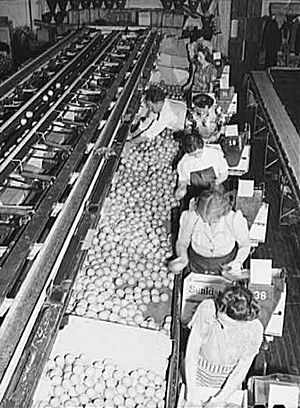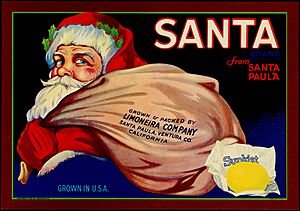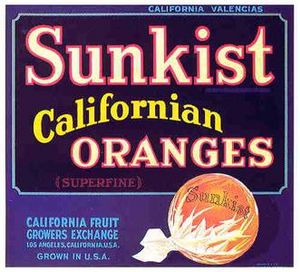Sunkist Growers, Incorporated facts for kids
 |
|

Sunkist headquarters in Valencia
|
|
| Agricultural marketing cooperative | |
| Industry | Agriculture |
| Founded | 1893 in Claremont, California |
| Founder | P.J. Dreher and Edward L. Dreher |
| Headquarters | Valencia, California, U.S. |
|
Area served
|
California and Arizona |
| Products | Citrus |
Sunkist Growers, Incorporated is a well-known company that helps citrus farmers sell their fruit. It started in 1893 and became known as Sunkist in 1909. The company is owned by over 1,000 farmers from California and Arizona. Its main office is in Valencia, California. Sunkist is one of the biggest fresh fruit sellers in the United States. It also helps process and market citrus fruits all over the world.
Contents
How Sunkist Began

In the late 1800s, citrus farmers in California faced challenges. They decided to work together to get better prices for their fruit. This way, they could share the risks and have more power when selling to big buyers. An economic downturn in 1893 made farmers want to organize even more.
In 1893, a group of citrus farmers and landowners formed the Southern California Fruit Exchange. This happened in Claremont, California. At first, it only included orange growers. But by 1896, lemon growers also joined. Farmers from many counties, like Los Angeles and Orange County, were part of it. By 1905, the exchange had 5,000 members. This was almost half of all citrus farmers in California! They then changed their name to the California Fruit Growers Exchange (CFGE).
In 1909, the CFGE started a big advertising campaign. They wanted to sell more "Sunkist" oranges in the Midwest. They sent tips to grocery stores on how to display oranges. Large newspaper ads told customers about the fruit. Stores even compared the prices of apples and oranges to show how good oranges were. This helped stores sell more fruit. A senator in Washington D.C. also sent "Sun-kist" oranges to important people. Their good comments were used to promote the fruit.
Between 1927 and 1939, the exchange sold over 75% of all California citrus. By the 1947–48 season, about 15,000 citrus growers were part of the exchange. In 1952, the company officially changed its name to Sunkist Growers, Inc..
How Sunkist Works
The Sunkist company has three main levels: local, district, and central. Individual farmers belong to their local group. Local groups are part of a district group. And district groups are part of the central organization. The main goal is to help farmers harvest, sort, pack, and ship their fruit efficiently. This way, fruit can be sent across the United States to meet demand.
Each level of Sunkist has a special job. Farmers agree to send all their fruit to their local packing unit. This unit helps harvest the citrus. Then, it treats, grades, and packs the fruit. Local groups also combine the fruit from many farmers and share the profits back to them. District groups act as the sales team for their local units. They set prices and decide where to sell the fruit. The central organization helps all the groups. It does research and gives advice. It has departments for accounting and advertising. It also supports scientific research on citrus.
Over the years, Sunkist has grown a lot. In 1906, they started the Citrus Protective League to speak up for farmers. In 1907, they created the Fruit Growers Supply Company. This company provided farmers with things like boxes, bug sprays, and fertilizers at good prices. Sunkist also formed the Sunkist's Exchange By-Products Company. This company found ways to use parts of the fruit that weren't sold fresh. They made things like citric acid and lemon oil.
The Sunkist Brand Story
Years ago, California had too many oranges. By 1907, they were growing five times more oranges than 15 years before. Many oranges couldn't be sold, and some trees were even cut down. A marketing expert named Albert Lasker wanted to stop this waste. In 1907, Sunkist started the first big advertising campaign for a fruit. They told people in Iowa that oranges were "healthy" and "summery." This made orange sales go up by 50% in that state!
This campaign also created the Sunkist brand. The advertising company first thought of "sun-kissed" to describe the oranges. But they chose "Sunkist" because it was easier to remember and protect as a brand name.
To make Sunkist oranges special, the company wrapped them in paper with the Sunkist name. In 1909, Sunkist found out that some stores were selling other oranges as Sunkist. So, they offered a free Sunkist spoon if people mailed in twelve Sunkist wrappers. One million spoons were given away in the first year! This helped people remember the brand and made stores want to display Sunkist oranges in their wrappers. By 1910, Sunkist was buying more spoons than anyone else in the world.
The early success made Sunkist invest a lot in advertising. They advertised in magazines, on the radio, on billboards, and even on speedboats! They also taught about oranges in schools and held essay contests. Their message was that oranges were not just for Christmas. Sunkist wanted people to believe oranges were important for good health and to eat one every day.

Sunkist also promoted fresh-squeezed orange juice and lemonade. They said these were better than "fake" drinks like Coca-Cola. By the mid-1930s, one out of every five Sunkist oranges was used for juice. Sunkist juice became the second most popular drink at soda fountains, after Coca-Cola.
By 1914, Americans were eating about 40 oranges per person each year. This was an 80% increase from 1885!
In 1915, Italian lemons were very popular in America. Sunkist started strongly promoting its own lemons. They suggested using lemons for hair rinses, in tea, in pie, and as a food garnish. By 1924, California lemons made up 90% of the American lemon market.
Sunkist Headquarters
In 1935, the eight-story Sunkist Building was built in Los Angeles. In 1970, Sunkist moved to a larger property in Sherman Oaks. The old building was taken down in 1972. In 2014, Sunkist Growers moved its main office to Valencia, California. This new location is close to Six Flags Magic Mountain.
Sunkist Today
In 2023, Sunkist celebrated its 130th anniversary. It is known as the longest-running agricultural cooperative in the U.S. On March 1, 2023, they celebrated "Sunkist Citrus Day." Sunkist works with over 1,500 members, many of whom are small family farmers. They offer more than 40 different citrus products.
As of 2007, Sunkist sells fresh oranges, lemons, limes, grapefruits, and tangerines. These come from 6,000 growers in California and Arizona. Sunkist also licenses its brand name to other companies. This means other companies can use the Sunkist name for their products. Over 600 citrus-flavored products, like soft drinks, vitamins, and candies, are sold in more than 50 countries. Sunkist also owns two plants that process citrus. These plants make juice, oils, and other products from the fruit.
Examples of Sunkist Products
Sunkist allows other companies to use its name for many products:
- Sunkist soft drinks, like "Sunkist Orange Soda," are made by Keurig Dr Pepper.
- "Sunkist Fruit Gems" are soft fruit candies made by Jelly Belly.
- "Sunkist Fruit Snacks" and "Sunkist Fruit & Grain Bars" are sold by General Mills.
- "Sunkist NFC Orange Juice and Juice Drinks" are products of A. Lassonde in Canada.
- "Sunkist Vitamin C & Supplements" are made by WN Pharmaceuticals in Canada.
- Sunkist juice and juice drinks are also found in many countries like Japan, South Korea, and Belgium.
See also


